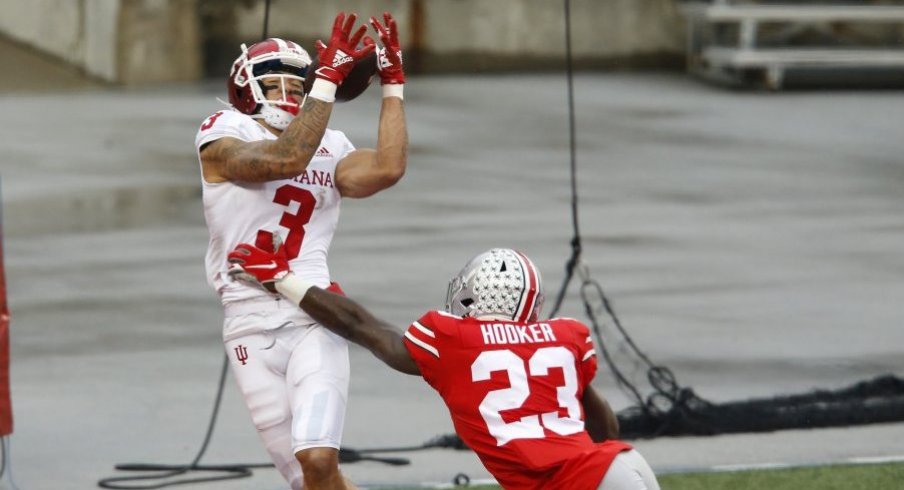Turns out, giving up nearly 500 yards passing and almost blowing a 35-7 lead over a then-top-10 Indiana team doesn't really impress the College Football Playoff committee.
The Buckeyes did earn a No. 4 ranking in the initial CFP rankings released last night but it's clear one reason they slotted behind a Clemson team with one loss is a problematic pass defense.
Ever since Kerry Coombs' secondary was shredded by Hoosiers quarterback Michael Penix Jr. and receiver Ty Fryfogle, among others, the topic du jour has been whether or not the position group can be addressed in a way that makes Ohio State a legit national title contender.
"We have to fix the big plays. There's no question about that. We need to make sure we're not chasing something that's not there that creates a big play."– OHIO STATE defensive coordinator kerry coombs
Coombs is clearly disappointed with his coaching and player execution and rightfully so after Penix Jr. engineered six pass plays of 20+ yards and a ridiculous four of 50+ yards.
Penix Jr.'s ten longest completions went for 361 of his 491 total passing yards on the day which served as the fourth-most surrendered by an Ohio State defense in school history.
Through four games, Coombs' pass defense ranks No. 54 in the country with eight plays allowed of 30+ yards. Twenty-six of the 53 defenses ranked ahead of Ohio State have even played more games than the Buckeyes. The four pass plays of 50+ yards allowed on Saturday were the first four such gashes permitted on the season but still slot Ohio State at No. 103 in the land.
For comparison, last year's dynamic secondary ranked No. 1 in the country after giving up just one pass play of 50+ yards in 14 games and No. 9 after giving up 11 pass plays of at least 30 yards.
While big plays have been an issue, big gainers aren't the only concern as the 2020 pass defense is yielding 291 yards per game, good for 115th in the nation. Last year's defense ranked No.1, allowing 156 yards, and even the sketchy 2018 defense fared better than 2020-to-date, placing No. 86 with 245 passing yards allowed per game.
One way to limit passing yards is obviously to force incompletions but even that's been a problem in 2020. Opposing quarterbacks are completing 63.3% of their throws over the first four games which is the 73rd-best mark in the country. Last year's defense allowed a completion percentage of 50.9% (No. 3) and the 2018 squad allowed a 55.6% rate (No. 29).
"I think we're getting very good pressure. We had 28 pressures and 10 knockdowns in the game Saturday. We'd like for these things to finish in more sacks." – OHIO STATE DEFENSIVE COORDINATOR KERRY COOMBS
Despite the defense giving up those 491 passing yards, the metrics do indicate the Buckeyes were able to pressure Penix Jr.
Unfortunately for them, the 28 pressures resulted in just two sacks but it's worth noting Penix Jr. completed only 52.9% of this throws on the afternoon, with some of that inaccuracy the product of Ohio State's pass rush.
Through four games, the Buckeyes do rank a respectable, though not spectacular, 35th in the land with 2.75 sacks per contest.
If your curious, of last night's top four in the CFP rankings, only Clemson bests the Buckeyes in this metric with 3.75 sacks per game, good for No. 6 nationally. Alabama ranks 98th averaging just 1.57 sacks and Notre Dame sits at No. 48 with a 2.63 average.
The Buckeyes have a chance to build some confidence this Saturday on the road against Illinois. The Illini have started four different quarterbacks in five games and the expectation is for Brandon Peters to get the call versus Ohio State.
In two games against Nebraska and Wisconsin, Peters is averaging 146 passing yards while completing 59.1% of this throws. Collectively, Illinois ranks No. 113 in the country averaging 159.4 passing yards per game. Up front, Illinois is allowing 2.2 sacks per game, good for No. 66 in the land.
This combo should not only help the pass defense feel better about itself but the pass rush might actually get home a few more times than we've seen the past two weeks (3 total sacks versus Rutgers and Indiana).


